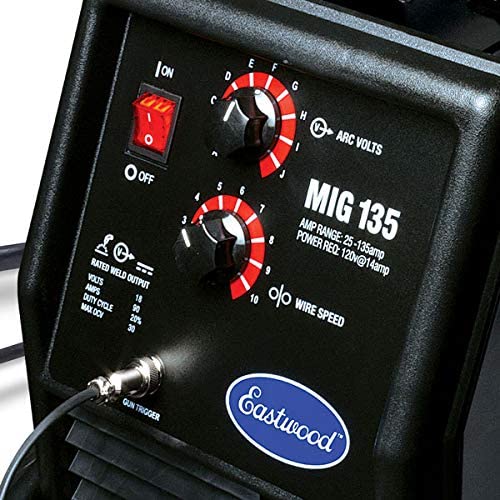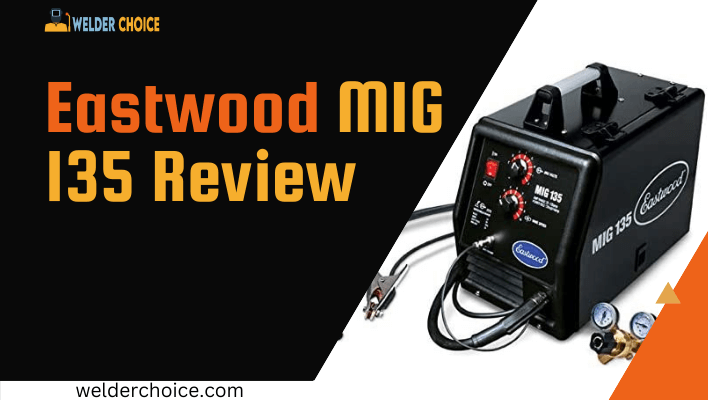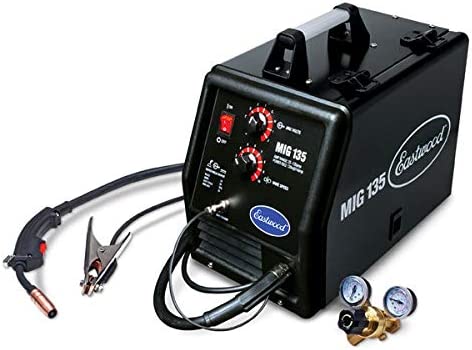We have provided you with this Eastwood MIG 135 review. One of the easiest techniques to master is MIG welding.
As long as you have the proper equipment, MIG welding is one of the easiest skills to master.
You will require a powerful machine to perform it, regardless of whether you are a professional welder or just a hobbyist who welds sometimes in a garage or auto-body shop.
Due to the overwhelming number of available machines, choosing the best MIG welder might be difficult. Fortunately, the Eastwood MIG 135 welder is one of the reasonably priced devices for sporadic usage that has sufficient functionality to meet your demands.
Although the Eastwood 135 MIG welder is a good budget option, is it the right tool for you? Find out by reading on.
Eastwood MIG 135 Review
Key Features:
- Voltage Required: 110/120 V
- 28 V DC is the maximum output voltage.
- Duty Cycle: 20% rated at 90 amp
- Range of Amps: 25-135 Amp
- Sizes of wire spools: 4 in. and 8 in.
- Size: 9.5 inches by 16.1 inches by 14.5 inches.
- Weight of Welder: 56 lbs.
You must first identify your needs in order to make the best decision and select the ideal welder. Power, utility, duty cycle, controls, and other crucial elements should all be taken into account. We’ll go over this economic package’s contents, features, advantages, and disadvantages to assist you in making your decision. We’ll discuss the characteristics, benefits, and downsides afterward.
Specifications
- Processes for welding: MIG, Flux Core
- Voltage Required: 110/120 V
- 28 V DC is the maximum output voltage.
- Duty Cycle: 20% rated at 90 amp
- Range of Amps: 25-135 Amp
- Materials: Aluminum, Stainless Steel, and Mild Wire Feed Control: Unlimited
- Length of the ground and torch lead: 8 ft.
- Length of Input Power Cord: 6 ft.
- Steel, Mild/Stainless Range of Welding (MIG): 24 gauge to 3/16 inch
- Steel, Mild/Stainless The flux core welding range is 24 gauge and 1/4 inch.
- Aluminum Metal Thickness: Welding (With an optional spool gun) Goes from 14 ga. to 1/8 in.
- MIG Wire Feed Speed Range: 40-450 IPM; Wire Thickness: 0.023-0.035 in WFS
- Sizes of wire spools: 4 in. and 8 in.
- Size: 9.5 inches by 16.1 inches by 14.5 inches.
- Weight of Welder: 56 lbs.
- Options for warranties: a three-year guarantee
Pros
- the excellent value of the funds invested
- It is portable and lightweight thanks to IGBT inverter technology.
- Effective welding and a lovely weld pool are made possible by infinite voltage control.
- On a simple control panel, a wire speed control with infinite adjustment is located.
- With solid core wire, it is possible to weld mild steel and stainless steel up to 3/16 in. thick.
- Flux-core welding has a spool gun that is able to weld aluminum and steel that is up to 1/4 in. thick.
- Welding up to 1/8″ aluminum, and MIG welding gun consumables are widely available.
- Wire strap with braids on the ground clamp
- There is also the gas regulator.
- 3-year hassle-free warranty, precise and well-written side door chart Negatives
Cons
- Not a MIG welder for industry
- You must purchase a flux wire.
- To run flux core wire smoothly, you’re going to require a knurled driving roll.
- Compared to similar welders, ground and torch leads are a little bit shorter.
- A spool gun is required to weld aluminum.
- Older models can run on a slightly heavier generator because they are built using transformer technology.
Features of the Eastwood 135
Launched in the fall of 1978, Curt Strohacker created an Eastwood company to serve better the expanding market of enthusiasts interested in auto restoration and customization.
The Eastwood Company is aware of the market’s shifting dynamics and works to keep current with them by prioritizing the demands and needs of its clients.
The market for automobile enthusiasts has grown beyond the “classics” in recent years, and Eastwood has observed a surge in demand for goods designed for muscle cars, street rods, trucks, and motorbikes. The business also produces top-notch inexpensive machines.
Let’s look over key characteristics to see if this is the best MIG welder for you.
Power Sources
One of the MIG welders that may be powered by a standard household current outlet is the Eastwood 135. It is therefore ideal for hobbyists and infrequent welders.
Like other lower amperage welding machines like the Hobart Handler 140 or the Harbor Freight Titanium 140, this welder requires a 120V outlet. Keep in mind that a 20 amp breaker is required to utilize almost everywhere without any problems.
The most recent iterations of the Eastwood 135 MIG welder employ inverter-based technology. This greatly enhances versatility because you can use a generator to power it practically anywhere you choose. Additionally, this 135 amp welder is lighter and more portable thanks to IGBT technology.
Note that you cannot use a generator to power an older model that employs a transformer-based technology architecture. The manufacture date is important because of this.
Duty Cycle
The simplest way to convey a duty cycle to someone who doesn’t know what it means is the amount of time your machine can weld during each 10-minute interval. For instance, the Eastwood 135 MIG welder has a 90 amp rating and a 20% duty cycle.
That indicates that you can weld for 2 minutes at 90 A before needing a break, for a total of 8 minutes. Because of this, it’s important to note that this is not an industrial machine designed for demanding and time-consuming labor.
Nevertheless, all other 140 amp MIG welders, including the Lincoln Easy MIG 140 and the Miller Millermatic 140, have almost the same rated duty cycle @ 20% 90 amps. However, Forney Easy 140 offers a duty cycle that is significantly higher, rated at 30%. Therefore, you should opt for a high-quality portable welder if you intend to weld frequently and frequently every day. On the other hand, let’s say you occasionally do your own welding, are a handyman, mechanic, light fabricator, farmer, or rancher, or intend to use it for welding bicycle frames or other straightforward welding jobs with thin steel. This duty cycle will satisfy your needs in the situation.
Output Amperes and Welding Power
The output amperage range of the Eastwood 135 MIG welder is 25–135 amps. This implies that as a welder, you may use it to join sheets of 24 gauge metal up to 3/16 inch thick in both mild and stainless steel.
Although it can weld steel up to 1/16 inches thick, some welding machines, like the Hobart Handler 140, have somewhat more power. However, performing multiple passes or using the flux-core welding procedure will yield greater results.
This strength is sufficient to meet your demands if you are a beginner who avoids taking on more demanding tasks. Additionally, because it is a reasonably priced MIG welder, you can use it until you have mastered your welding techniques. Once you do, you can always choose an advanced welder.
Due to the significantly slower wire feed speed of Eastwood 135, you cannot weld aluminum right out of the box. Nevertheless, this welder is equipped with a spool gun. You can weld aluminum 14 gauge up to 1/8 in. thick with an extra 20172 spool gun. Additionally, the spool gun substantially improves aluminum welding capabilities and decreases the likelihood of birds nesting, but you will need to purchase it separately.
Design and Build Welder
Although this welder is built in China, one of the first things you’ll notice about it is that it doesn’t appear to be of low quality. Instead, the general layout resembles that of US machines with well-known brands.
The drive roll mechanism, though, is among the things that don’t feel right. The major flaw is that the welder doesn’t come with a knurled drive roll, which you really shouldn’t anticipate given the price range of MIG welding.
Due to the smooth wire feed and increased flux core capabilities provided by a knurled roller, you cannot execute flux core welding activities effectively. Additionally, given that the package content is very constrained, you should purchase some flux-core wire while you are at the store if you wish to weld flux core.
Chart for Side Panel Settings
We can all agree that a side panel setting chart is a need for any respectable welder. This is crucial for beginners who are still learning and attempting to make beads of great quality.
Fortunately, the Eastwood 135 is one of the MIG welders that includes a clear and thorough chart directly on the unit’s door to guide you in selecting the appropriate settings for the specified material thickness. Although the settings are good to get you started, you might wish to adjust them later.
Welder Settings and Controls

A simple but effective control panel is included with the Eastwood MIG 135 welder. There are only three controls: a wire feed speed and voltage knob, and an on/off switch. Therefore, running your welder won’t be similar to flying because of all the controls and screens.
A four- or five-stepped voltage knob is typically seen when looking at the welder pricing range. The Eastwood MIG 135 excels in this regard because it has an unlimited control voltage knob similar to those used on much more expensive equipment, such as the Millermatic 140.
As one of the fantastic advantages you may have in a low-cost machine, this implies you can adjust your heat. Additionally, it has an adjustable wire speed control, making it ideal for anyone who enjoys fine-tuning their welder setup.
Leads, a MIG gun, and a ground clamp
Since the Eastwood 135 employs a Tweco-style torch, consumables and replacement parts are widely available. On the weekends, you can also find replacement parts at big box stores.
Despite the fact that this welder doesn’t come with a spool gun—which we just mentioned—you still get a lot of use out of it.
The lead length is one of the possible complaints. Compared to comparable versions like the Hobart Handler 140 or Millermatic 140, which have 10 ft. leads, the Eastwood 135 has 8 ft. leads. Although leads are sufficient for use in a small shop, if you intend to weld outside, you might wish to purchase a more prolonged replacement.
Cost to Quality Ratio
The price-to-quality ratio of an Eastwood 135 MIG welder is one of its most important benefits. Some of the top features and precise settings found on more expensive, rival welders like the Forney Easy 140 or Hobart 140 are available on this machine. Even so, it is clearly less expensive than the two welders described.
However, a cheaper price doesn’t always imply a subpar item. Eastwood made sure the construction quality was appropriate for the specified uses. Because of this, we can state that the Eastwood MIG 135 has a good price-to-quality ratio.
Mobility and weight
The weight of the newest Eastwood MIG 135 model, which uses an inverter-based design and weighs roughly 56 pounds, is lower than that of the prior model, which used transformer technology and weighed 64 pounds.
This MIG welder is still quite portable even though it is a little heavier. But depending on the size of the container, lugging a shielding gas cylinder about may be somewhat cumbersome. As a result, you might wish to build a good welding cart for it or perhaps use it as your new welder’s first project.
Eastwood MIG 135 weighs much more than Forney Easy 140, which weighs 27 lbs, but slightly less than Millermatic 140, which weighs 60 lbs when compared to welders with comparable input amperage.
Customer Experience
You come across numerous postings where pleased owners express their pleasant experiences while perusing forums where the Eastwood MIG 135 seems to be a topic. The majority of compliments center on the product’s construction quality, bead smoothness, and affordable price.
In addition, new users rave about how simple it is to use, which is crucial. Free technical support is one of the things that stands out when reading reviews.
Customers typically want to know that the manufacturer cares about them, thus Eastwood makes an effort to address all of their inquiries.
Owners generally agree that the Eastwood MIG 135 is a good welder that you will like using.
Final Thoughts
One of the reasons this adaptable welder would be ideal for beginners is that MIG welding in general is a beginner-friendly way to learn. It is also a reasonably cheap welder to learn the art, which is another important aspect in addition to the simple methods.
After reading this Eastwood MIG 135 review, we can conclude that this machine only has 135 Amps. Since it does not burn as hot as heavy-duty welders, it is ideal for working on thin weld materials, exhaust pipes, farm projects, or restoration jobs. By chance, it would also be a good high-quality machine for you whether you are a metal fabricator or a home hobbyist.
If you don’t need to weld exceptionally thick metals for an extended period of time, the Eastwood MIG 135 is the ideal welder. But in that situation, I advise getting a more powerful machine for a better welding experience.

With 8 years of experience a senior welding instructor and safety equipment researcher and writes articles, reviews and guidelines on helmets and other welding and safety gears at Welder Choice, and other written works have been published in various publications.

